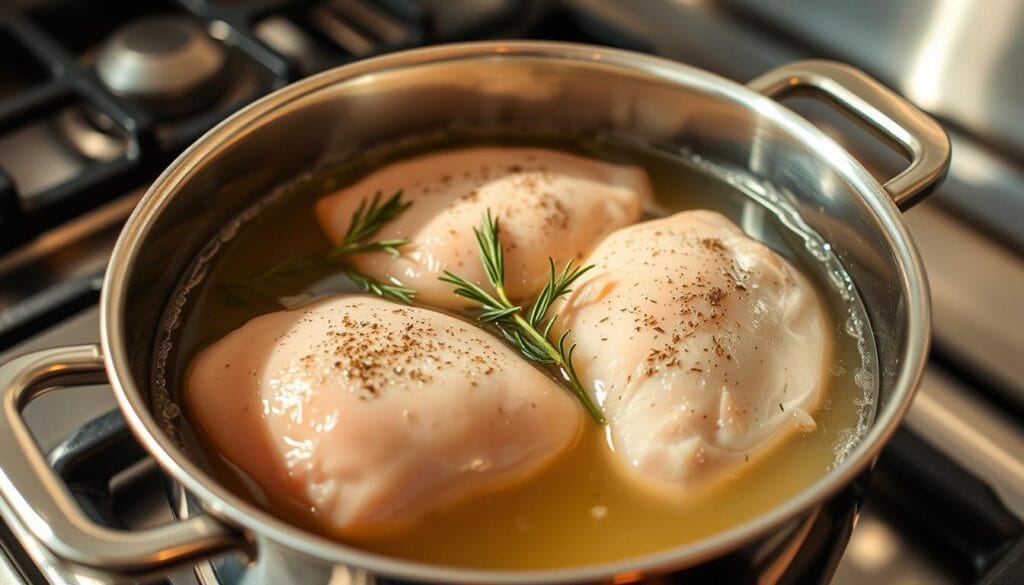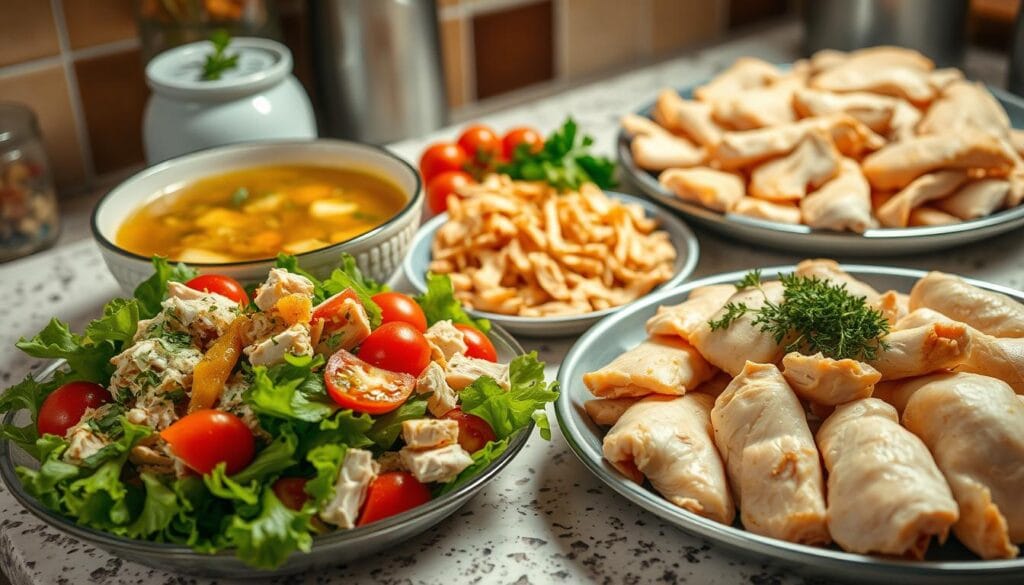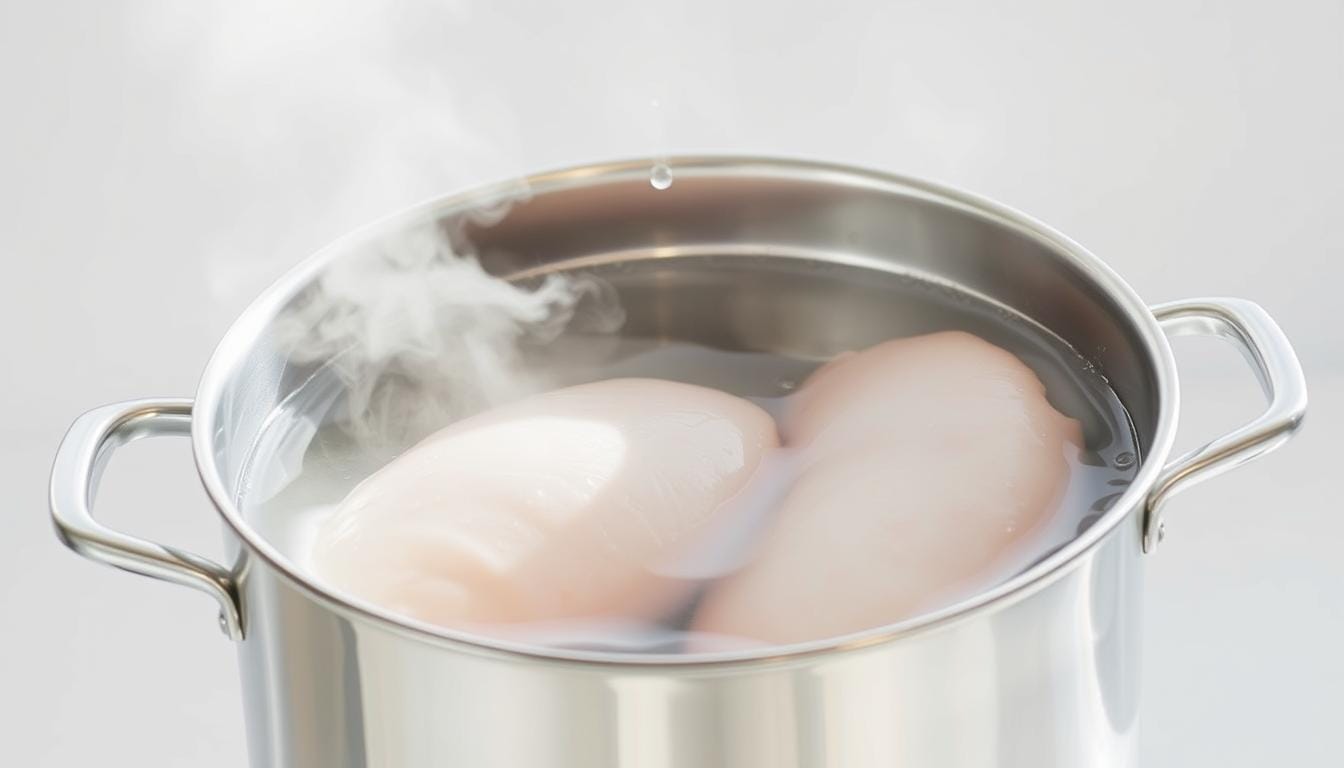Mastering the Art of Boiling Chicken: A Quick Tutorial
Every home cook has faced the problem of dry, tasteless chicken. Learning how to boil chicken can change your cooking game. It turns bland protein into tender, juicy meat that’s perfect for many dishes.
Boiling chicken is more than just cooking—it’s a skill that makes your kitchen more versatile. It’s great for quick dinners or meal prep. Knowing how to boil chicken boosts your cooking confidence.
This tutorial will show you how to boil chicken step by step. You’ll learn how to pick the right chicken cuts and cook it to perfection. The result is moist, flavorful meat ready for any dish you can think of.
Table of Contents
Essential Equipment and Ingredients for Boiling Chicken
Before you start boiling chicken breast, you need to plan and gather the right tools. Having the right equipment and ingredients is key to a tasty and successful meal.
Basic Kitchen Tools You’ll Need
To boil chicken breast well, you’ll need these basic tools:
- Large pot or Dutch oven
- Meat thermometer
- Sharp kitchen knife
- Cutting board
- Tongs or slotted spoon
- Paper towels
Selecting the Right Chicken Cuts
Choosing the right chicken cut is important. Boneless, skinless chicken breasts are popular for their quick and even cooking. Think about these when picking your chicken:
- Fresh vs. frozen chicken
- Thickness of the chicken pieces
- Bone-in or boneless options
Seasoning and Aromatics Options
Make your boiled chicken breast more flavorful with seasonings and aromatics. Here are some great options:
- Fresh herbs like parsley, thyme, or rosemary
- Garlic and onion
- Salt and pepper
- Bay leaves
- Peppercorns
Use ½ teaspoon of salt per pound of meat. Aim for an internal temperature of 165°F. Proper preparation makes your meal safe and delicious.
How to Boil Chicken: Step-by-Step Guide
Learning to boil chicken to shred is a key skill in the kitchen. It can change how you prepare meals. The steps are important to get tender, tasty chicken every time.
First, pick the right chicken for shredding. Boneless, skinless chicken breasts are best. Choose 1-2 pounds of chicken, or about 2-3 breasts, for the best results.
- Select a large pot with enough space for chicken and water
- Fill the pot halfway with cold water
- Add 1 tablespoon of salt for seasoning
- Optional: Include herbs or spices for extra flavor
Water temperature is key when boiling chicken to shred. Start with cold water and slowly heat it up. This keeps the meat tender and moist.
| Chicken Type | Boiling Time | Internal Temperature |
|---|---|---|
| Boneless, Skinless Breasts | 12-15 minutes | 165°F |
| Frozen Chicken | 18-22 minutes | 165°F |
| Cut into 2-inch pieces | 8-10 minutes | 165°F |
After boiling, let the chicken rest for 5 minutes before shredding. This keeps it moist. Use two forks or a stand mixer with a paddle for quick shredding. Avoid over-shredding to prevent mushy meat.
Pro tip: The cooking liquid can be saved for stocks, beans, or grains, adding extra flavor to future dishes.
Perfect Timing Guide for Different Chicken Cuts
Learning how long to boil chicken is key to getting tender meat. Each chicken cut needs a specific cooking time for the best results. Knowing these times will make your dishes delicious and satisfying.
When figuring out how long to boil chicken, remember these important points:
- Chicken cut type
- Bone-in or boneless
- Meat thickness
- Fresh or frozen
Chicken Breast Boiling Guide
Chicken breasts are packed with protein, about 31g per 100g. Here’s what you need to know for boiling:
| Chicken Breast Type | Boiling Time | Notes |
|---|---|---|
| Boneless, fresh | 10-15 minutes | Ensure internal temperature reaches 165°F |
| Bone-in, fresh | 15-20 minutes | Check thickness and adjust accordingly |
| Frozen boneless | 12-18 minutes | May require additional cooking time |
Whole Chicken and Larger Cuts
Boiling whole chickens or larger cuts takes longer. Patience is key to achieving perfectly cooked meat. A whole chicken usually boils for 30-40 minutes, depending on its size.
Thighs and Drumsticks Timing
Chicken thighs and drumsticks have more fat, making them easier to cook. Here are the boiling times for these cuts:
- Boneless thighs: 10-12 minutes
- Bone-in thighs: 15-18 minutes
- Drumsticks: 15-20 minutes
Always check the chicken’s internal temperature with a meat thermometer. It should be 165°F for safety. After boiling, let the chicken rest for 5 minutes. This helps keep it moist and flavorful.
Seasoning Techniques for Flavorful Boiled Chicken

Seasoning is key when boiling chicken. It turns a simple dish into a tasty meal. The right mix of herbs, spices, and aromatics makes all the difference.
Begin by making a flavorful liquid base. Here are some seasoning tips:
- Use chicken broth instead of water for instant flavor boost
- Add aromatic herbs like thyme, rosemary, and bay leaves
- Include whole garlic cloves and quartered onions
- Experiment with salt, pepper, and ground cumin
To boil chicken with lots of flavor, infuse your liquid. A good mix is 4 cups of chicken broth with special seasonings.
| Seasoning Type | Quantity | Flavor Profile |
|---|---|---|
| Kosher Salt | 1 teaspoon | Enhances natural chicken taste |
| Ground Cumin | 1½ teaspoons | Adds warm, earthy notes |
| Black Pepper | ½ teaspoon | Provides subtle heat |
| Garlic Cloves | 4 whole cloves | Introduces rich, aromatic flavor |
Brining your chicken before boiling is a pro tip. It keeps the chicken moist and flavorful. Just mix ½ cup of table salt in 2 quarts of water. Let the chicken soak for 30 minutes before cooking.
The aim is to create a dish with layers of flavor. This makes your boiled chicken truly irresistible.
How to Tell When Your Chicken is Properly Cooked
Knowing how long to boil chicken is key for safety and taste. It makes sure your meal is tasty and safe from harmful bacteria.
Temperature Testing Methods
The best way to check chicken is with a meat thermometer. You need to hit a certain internal temperature for food safety.
- Insert the thermometer into the thickest part of the chicken
- Ensure the reading reaches 165°F (74°C)
- Wait a few seconds for an accurate measurement
Visual Indicators of Doneness
Visual signs also show if chicken is cooked. Color and clarity of juices are important.
| Chicken Type | Color Indicator | Juice Color |
|---|---|---|
| Chicken Breast | Opaque white | Clear |
| Dark Meat | White with slight pink | Light pink |
Texture Check Guidelines
Texture is another clue for chicken doneness. It should be firm but tender when pressed.
- Press the chicken with a fork
- Check for resistance
- Verify no pink remains inside
Remember, chicken will cook a bit more after it’s off the heat. Let it rest for a few minutes before eating.
Tips for Shredding and Storing Boiled Chicken
Learning to boil chicken to shred is key for home cooks. Once your chicken is boiled just right, you’ll want to shred it. This makes it tender and delicious.
Shredding methods depend on how much chicken you have and your tools. Here are some top ways to shred chicken:
- Fork Method: Use two forks to pull the chicken apart, working against the grain of the meat
- Stand Mixer Technique: For larger quantities, use a stand mixer with a paddle attachment to quickly shred chicken
- Hand Mixer Approach: A hand mixer can create perfectly shredded chicken in seconds
Proper storage keeps your shredded chicken tasty and safe. Follow these tips:
| Storage Method | Duration | Best Practices |
|---|---|---|
| Refrigeration | Up to 4 days | Store in airtight container |
| Freezing | Up to 3 months | Use freezer-safe containers or bags |
Pro tip: Always cool your boiled chicken completely before storing. For refrigeration, use shallow containers. This helps the chicken cool fast and prevents bacteria.
When you’re ready to use your shredded chicken, it’s perfect for tacos, salads, sandwiches, and more. It’s a versatile protein for many tasty recipes.
Common Mistakes to Avoid When Boiling Chicken
Boiling chicken might seem easy, but many mistakes can ruin your dish. Knowing these common errors helps you cook chicken breast perfectly. This way, you’ll get tender and tasty results.
Temperature Control Challenges
Getting the right temperature is key when boiling chicken. High heat can make your chicken tough and rubbery. Instead, aim for a gentle simmer.
- Keep water temperature between 180-190°F
- Avoid rolling boils that break down protein structures
- Use a reliable meat thermometer for precision
Seasoning Mistakes
Seasoning is not just an afterthought when boiling chicken. Not seasoning enough or adding it too late can make the meat taste bland.
- Salt the water before adding chicken
- Consider aromatics like herbs and garlic
- Avoid oversalting, which can dry out the meat
Storage and Safety Errors
Storing chicken properly is vital to prevent bacterial growth and keep it fresh. Many home cooks make mistakes that can lead to foodborne illnesses.
| Storage Mistake | Potential Consequence | Correct Practice |
|---|---|---|
| Leaving chicken at room temperature | Bacterial growth | Refrigerate within 2 hours |
| Improper container storage | Cross-contamination | Use airtight containers |
| Extended refrigeration | Quality degradation | Consume within 3-4 days |
Pro tip: Always cool boiled chicken quickly and store it properly. This keeps its texture and prevents bacterial growth. Your careful steps ensure delicious and safe meals.
Creative Ways to Use Your Boiled Chicken

Learning to boil chicken opens up a world of possibilities. Your boiled chicken can turn into many meals, saving you time and adding healthy goodness to your diet.
Here are exciting ways to reimagine your boiled chicken:
- Quick Lunch Solutions
- Chicken salad sandwiches
- Wrap fillings
- Protein-packed green salads
- Dinner Inspirations
- Hearty soups
- Casserole toppings
- Enchilada fillings
Knowing how to boil chicken right opens up endless possibilities in the kitchen. Most recipes make 6-10 servings, making meal prep easy and tasty.
Pro tip: Shred, dice, or slice your boiled chicken and store it in airtight containers. This way, you can quickly make meals all week, cutting down on cooking time.
International dishes offer many chances to show off your boiled chicken skills. From Mexican to Asian stir-fries, your chicken can fit any flavor.
Conclusion
Learning to boil chicken is a key skill in cooking. It lets you make many tasty dishes. To boil chicken right, pick the right cut and check the temperature to 165°F for safety.
Now you know how to boil chicken, making healthy, protein-rich meals easy. You can use boiled chicken in salads, sandwiches, and soups. Boiling chicken is quick, healthy, and fits well into your cooking routine.
Keep practicing to get better at boiling chicken. Try different seasonings and chicken cuts. Boiled chicken is great for quick meals or meal prep, and you can make it your own.
With this guide, you can make tender, tasty boiled chicken. Your cooking skills have grown, and you’re ready to try new recipes.
FAQ
How long does it take to boil chicken breasts?
Can I boil frozen chicken?
How do I know when boiled chicken is fully cooked?
What’s the best way to shred boiled chicken?
Can I add flavor when boiling chicken?
How long can I store boiled chicken in the refrigerator?
Is boiled chicken healthy?
Can I boil a whole chicken?
What’s the difference between boiling and simmering chicken?
Can I use boiled chicken in cold dishes?
have you tried our recipe?
There are no reviews yet. Be the first one to write one.


